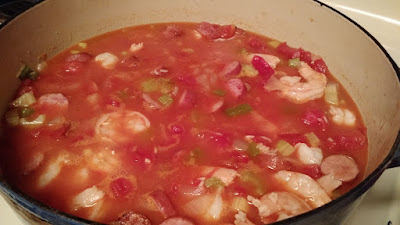An important distinction to make is Creole vs Cajun. Cajun comes from the term "Acadiana" which describes the central and southern Louisiana areas and its culture. Creole refers to the people and culture that blended the French colonial culture with African, Caribbean, and native people.
Cajun cuisine uses a limited set of ingredients, which were easily accessible to the area. Ingredients often traveled along the Missisippi river and local roads. It's generally considered "country food."
Creole cuisine has access to a wider pantry, due to the trading through the port of New Orleans. The people brought a "big city" spin on the classic Cajun dishes. Since this jambalaya uses tomatoes, it's considered Creole (although my family grew tomatoes in Bossier City, LA).
This recipe will be very familiar to those who are playing along at home (LINK to Gumbo). Instead of being a soup, it's a rice-based dish with similar preparation and ingredients. The recipe comes from the Junior League of Lake Charles and their book "Pirate's Pantry."

We begin by chopping the mirepoix (celery, onion, and bell pepper) with a couple cloves of garlic.
Slice the sausage and allow the shrimp to thaw.
Start the roux with canola oil and flour.
Once the roux is "blonde" drop in the sausage.
After a couple minutes of browning, drop in the bell pepper (since it takes longer to cook).
After a couple minutes, drop in the onion and celery.
After a couple minutes, drop in the garlic and keep stirring to prevent burned garlic.
If you're using the Creole recipe, add diced tomatoes and some water to "soupy" consistency.
Add your favorite spice blend. Generally, jambalaya is not prepared as spicy as gumbo, but the world is your spice cabinet.
Let the sausage and veggie mixture stew. Add the spice blend, then peel the shrimp.
Drop in the shrimp and rice.
Bring to a boil and allow to simmer until the rice has absorbed all of the liquid.
The final product should look like this:
Remove the bay leaves and serve with some green onions on top.

















No comments:
Post a Comment
Note: Only a member of this blog may post a comment.